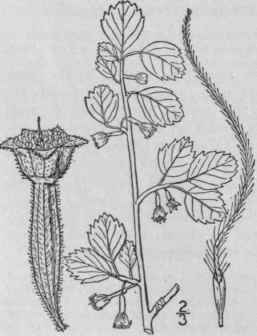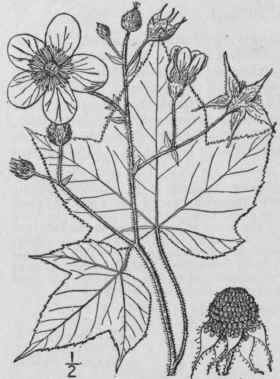27. CercocÓrpus H.B.K. Nov. Gen. Et Sp. 6: 232. 1823
Description
This section is from the book "An Illustrated Flora Of The Northern United States, Canada And The British Possessions Vol2", by Nathaniel Lord Britton, Addison Brown. Also available from Amazon: An Illustrated Flora of the Northern United States, Canada and the British Possessions. 3 Volume Set..
27. CercocÓrpus H.B.K. Nov. Gen. Et Sp. 6: 232. 1823
Shrubs or small trees, with alternate simple petioled coriaceous dentate or entire, stipulate, prominently straight-veined leaves, and short-pedicelled or sessile, solitary or clustered, axillary or terminal, perfect flowers. Calyx narrowly tubular, persistent, contracted at the throat, 5-lobed. Petals none. Stamens 15-25, inserted in 2 or 3 rows on the limb of the calyx; filaments very short; anthers oval, often pubescent. Ovary 1, terete, slender, included in the calyx-tube, ripening into a villous achene; style filiform, villous, persistent, plumose and elongated in fruit; stigma obtuse; ovule solitary, nearly erect. Seed linear, its testa membranous. [Greek, tailed-fruit.]
About 10 species, natives of western North America and Mexico. Type species: Cercocarpus fothergilloides H.B.K.

1. Cercocarpus MontÓnus Raf. Small-Leaved Cercocarpus
Fig. 2287
Cercocarpus montanus Raf. Atl. Journ. 146. 1832-33. Cercocarpus parvifolius Nutt.; H. & A. Bot. Beechey Voy. 337. 1841.
A low branching shrub. Leaves obovate or oval, coriaceous, obtuse at the apex, cuneate or sometimes rounded at the base, short-petioled, dentate, silky-pubescent or canescent below, sparingly so or glabrous above, 6"-12" long, 3"-8" broad; flowers axillary, solitary or in pairs, short-peduncled, recurved, about 3" broad; calyx-tube pubescent, 4"-6" long, its limb deciduous; style becoming 2'-4' long and very plumose in fruit.
In dry or rocky soil, South Dakota to western Kansas, Montana, Wyoming, Utah and New Mexico. April-June.
28. R┘BUS [Tourn.] L. Sp. Pl. 492. 1753.
Perennial herbs, shrubs or trailing vines, often prickly, with alternate simple lobed or 3-7-foliolate leaves, the stipules adnate to the petiole. Flowers terminal or axillary, solitary, racemose or panicled, white, pink or purple, perfect or sometimes dioecious. Calyx persistent, not bracted, deeply 5-parted, its tube short and broad. Petals 5, deciduous. Stamens ∞, usually numerous, inserted on the calyx, distinct. Carpels ∞, rarely few, inserted on a convex or elongated receptacle, ripening into drupelets and forming an aggregate fruit, which in many species is edible, sweet and delicious, in others sour, or nearly tasteless. Ovules 2, one abortive. Style nearly terminal, slender. Seed pendulous. [The ancient name of the bramble, from ruber, red.]
Perhaps 200 species, of wide geographic distribution, most abundant in the north temperate zone. Besides the following, several others occur in North America beyond our area. A great many species, based mainly on trivial characters of pubescence, habit and leaf-form have been described since the publication of our first edition; many of these are hybrids between the different blackberries and others are races. There is great difference of opinion, both in Europe and America, regarding the number of valid species. All the British brambles were reduced to a single species, R. fruticosus L., by Bentham, but other authors have recognized and described a large number. The stems of many species are biennial. Several species are widely cultivated for their edible fruits, which have been improvd by selection. Type species: Rubus fruticosus L.
Leaves simple, crenate or palmately lobed. [Genus Rubacer Rydb.] | ||
Shrubby, 2°-5° high, branched; flowers corymbose. | ||
Flowers numerous, red-purple. | 1. | R. odoratus. |
Flowers few, white; western. | 2. | R. parviflorus. |
Herbaceous, 3'-9' high, simple; flowers solitary, white. | 3. | R. Chamaemorus. |
Leaves 3-7-foliolate (rarely simple in a race of No. 4). | ||
Fruit falling away from the dry receptacle. Raspberries. | ||
Stems bristly, not glaucous; fruit light red. | 4. | R. strigosus. |
Stems prickly, slightly glaucous; fruit dark red. | 5. | R. neglectus. |
Stems prickly, very glaucous; fruit normally purple-black. | 6. | R. occidentalis. |
Fruit persistent on the fleshy receptacle. Blackberries. | ||
Herbaceous, unarmed; fruit red to purple. | ||
Erect, 10' high or less; petals obovate, usually pink. | 7. | R. arcticus. |
Trailing or ascending; petals spatulate-oblong, white. | 8. | R. triflorus. |
Shrubby, usually bristly or prickly; fruit black when ripe. | ||
Leaves White-woolly beneath; stems erect or nearly so. | 9. | R. cuneifolius. |
Leaves not white-woolly beneath. | ||
Stems erect., ascending, or arching. | ||
Unarmed, or with very few distant prickles; leaves glabrous on both sides. | ||
10. | R. canadensis. | |
More or less densely prickly, or bristly. | ||
Leaves glabrous on both sides. | 11. | R. nigricans. |
Leaves velvety-pubescent beneath. | ||
Inflorescence with few or several unifoliolate leaves; fruit subglobose. | ||
12. | R. frondosus. | |
Inflorescence not leafy; fruit oblong to cylindric. | ||
Pedicels without prickles. | 13. | R. alleghanensis. |
Pedicels prickly. | 14. | R. argutus. |
Stems trailing or procumbent. | ||
Leaves dull above; fruit black. | ||
Leaves deciduous. | ||
Leaflets pubescent beneath, mostly rounded or cordate at base. | ||
15. | R. Baileyanus. | |
Leaflets glabrous or nearly so, mostly narrowed at base. | 16. | R. procumbens. |
Leaves coriaceous, persistent. | 17. | R. trivialis. |
Leaves shining above; fruit reddish. | 18. | R. hispidus. |

Continue to:


